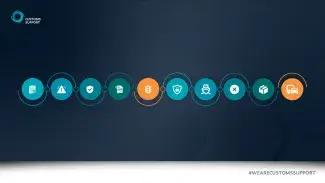2024
Customs changes in the UK – January 2024
From 31st January 2024, the following changes to UK customs legislation have been observed
Border Target Operating Model (BTOM) Health Certificate requirements for low-, medium-, and high-risk imports from the EU
Changes to legislation for imports of animal products, plants, and non-animal foodstuffs from the EU came into effect in January. These are now categorised as low-, medium-, and high-risk as part of the Border Target Operating Model.
Depending on the risk category of your shipment, you need a minimum amount of supporting documents to accompany your goods. A supplementary declaration may also be required.
DEFRA released a list of common errors shortly after this change in UK customs legislation to help you prevent and correct them before they cause delays or penalties.
Full customs control for goods moving from Irish ports to GB
Since Brexit, customs controls for goods moving between the Republic of Ireland, Northern Ireland, and Great Britain have moved at a different pace to other UK/EU changes in legislation.
Since 31st January, goods from the Republic of Ireland have needed full import customs clearance controls when shipping to the UK. Goods from Northern Ireland may also need full declarations if they travel through the Republic of Ireland or are not qualifying goods.
Document waiver code 999L removed for import clearances
The 999L code on the Customs Declaration Service (CDS) allowed for the bypassing of prohibition and restrictions (P&Rs) documentation. It was the new version of LIC99 from the old Customs Handling of Import and Export Freight (CHIEF) system, and was added after the launch of CDS to assist traders with the transition.
However, the LIC99-type functionality was not intended to be brought forward with the change to CDS, and HMRC advised that this would only be a temporary feature. The original timeframe was extended, but 999L was eventually removed for imports on CDS at the end of January.
March 2024 – changes to UK customs legislation surrounding food and feed
From 7th March, there are new documentation criteria for food and feed of non-animal origin. Generally, this affects your goods if they require a CHED-D document.
To ensure that goods meet the new standards, there is also a temporary increase in the number of examinations for each type and origin of consignment.
April 2024 – UK customs legislation changes to rollout BTOM risk categories to non-EU imports
From the 30th of April, the BTOM risk categories introduced in January for EU-originating products will extend to non-EU products.
Furthermore, random physical checks will begin on those goods that qualified for additional checks in January (EU-originating).
May 2024 – Changes to SCDP and SEDP
In May, there are changes coming to the Simplified Customs Declarations Process (SCDP) and the Simplified Export Declaration Process (SEDP). The changes aim to increase collation time for traders so that they can meet their requirements, in response to evidence within the industry.
Businesses will now have more time to complete declarations, and the duty deferment account (DDA) payment date for all CDS users will be extended from the 15th calendar day of each month to the 16th calendar day.
You may also apply for the option to aggregate supplementary declarations across a calendar month.
June 2024 – ICS2 for maritime transport
On June 3rd, the EU’s Import Control System 2 will complete its third phase, rolling out pre-arrival safety and security data requirements to maritime traffic. Until now, only postal, express, and air freight have been required to submit the Entry Summary Declaration (ENS) before departure.
One further release will be done in April 2025, when road and rail operators will also need to follow ICS2 protocols.
July 2024 – NCTS 5
From the 1st July, the New Computerised Transit System Phase 5 (NCTS 5) system will be live in the UK. This system is shared with the EU and is used to facilitate transit clearances.
September 2024 – Windsor Framework UKIMS “green lane” access
At the end of September, the UK customs legislation changes from the Windsor Framework will start to come into effect.
If you are registered on the UK Internal Market Scheme (UKIMS) (previously the UK Traders Scheme), then you can gain access to the green lane processes for qualifying shipments – provided your goods are:
- Eligible for “not at risk” categorisation.
- Already in free circulation or released for home use.
- Are for sale or final use by a consumer in the UK.
If this applies to you and your goods, this is what this means for you:
- Access to the Simplified Process for Internal Market Movements (SPIMM), which allow you to use a reduced dataset, no supplementary declarations*, and the use of six-digit HS codes for declarations in association with your Trader Goods Profile.
- No customs inspections unless through intelligence monitoring.
- Easier and faster clearances.
- No duty to be paid.
*Note that some sanitary and phytosanitary goods will still require supplementary declarations to relevant authorities.
2025
31st January 2025
999L removed from export declarations
Similar to the removal from import declarations in January 2024, code 999L will be considered obsolete for export declarations from the end of January 2025.
S&S declarations for EU imports (previously due October 2024)
Similar to the ICS2 pre-arrival safety and security declarations in the EU, the UK will require S&S notifications for some transport lanes from October.
However, note that additional work and duplicate information will be reduced despite the additional declaration, due to a reduced dataset on the arrival entry.
1st April 2025 – ICS2 for road and rail transport
Following the maritime release in 2024, rail and road carriers will be required to follow ICS2 protocols from April 2025. This will mean that all modes of transport will have migrated to ICS2.
January 2027 – UK Carbon Border Adjustment Mechanism
HMRC has published a consultation for a UK version of the Carbon Border Adjustment Model, which is an initiative in the EU designed to offset embedded emissions in some imported products.
Currently, the UK is proposing to apply this mechanism to the following sectors:
- Aluminium
- Cement
- Ceramics
- Fertilisers
- Glass
- Hydrogen
- Iron
- Steel
Similar to the EU’s CBAM rollout, it has been proposed that there will be two methods of calculating emissions: either with real data or government-provided defaults in the event that this information is unavailable.
Additionally, any carbon which has already been offset at origin may also be eligible for waiver to avoid double payments. This will be subject to evidence of direct carbon offset fees.
As with the EU’s carbon mechanism, the government has proposed a year of transition, with the first accounting period being from the 1st January to the 31st December. From 2028, accounting periods will be quarterly.
A small but important difference: unlike the EU’s CBAM, which places obligations on the importer of record at the port of entry, the UK has proposed that CBAM will only apply to goods which are released into free circulation – with some exceptions.
There is also a barrier for registration, with importers needing to reach a threshold of £10,000 per annum.
The consultation period ended on the 13th of June 2024, but there have been no further updates on the proposed rollout. Please bear in mind that the above may change before the UK CBAM comes into effect.
Need advice on the upcoming UK customs legislation changes?
Our team is here to help you. Whether you need specific advice based on your goods classification, general advice on UK customs clearance, or help with understanding what you need your trading partners to do, Customs Support has you covered.
For help with upcoming UK legislation changes, get in touch today.
To view a PDF version of this timeline, please download it from the link below!














